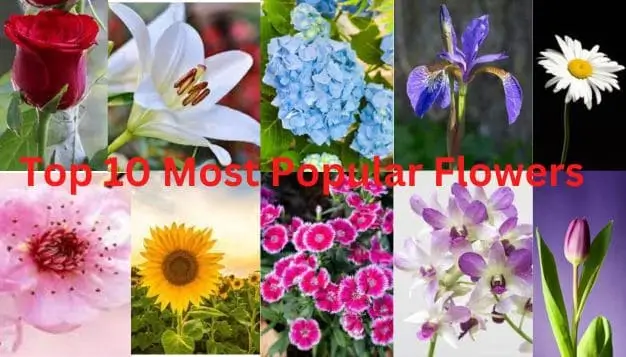Flowers have been a source of fascination and inspiration for centuries, captivating people with their beauty, fragrance, and symbolic meanings. Across cultures and civilizations, flowers have played a significant role in conveying emotions, messages, and sentiments.
Flowers have been a meaningful part of human culture for thousands of years. Different flowers have come to represent different emotions, relationships, events, and meanings. While tastes and traditions vary around the world, some flowers consistently remain popular across cultures for their beauty, fragrance, availability, and symbolism.
In this exploration, we delve into the top 10 most popular flowers and unravel the profound meanings they carry.
Rose
Undoubtedly the most iconic and universally recognized flower, the rose has held a special place in human culture for centuries. The different colors of roses convey a range of emotions and sentiments. Red roses, for example, symbolize love and passion, while white roses represent purity and innocence. Yellow roses convey friendship and joy, making the rose a versatile flower with a rich tapestry of meanings.
The thorns on roses symbolize sacrifice, pain, and thoughtfulness. Roses have one of the widest ranges of meanings, which makes them a popular choice for everything from weddings to get well gifts.
Lily
Lilies are renowned for their elegance and grace, making them a popular choice in both bouquets and gardens. With a variety of species and colors, lilies carry diverse meanings. The white lily is often associated with purity and virtue, while the vibrant orange lily symbolizes passion and confidence. Lilies are frequently used in religious and cultural ceremonies, further emphasizing their significance.
Tulip
Tulips are a classic spring flower, which makes them a frequent choice for Easter celebrations and springtime displays. Tulips, with their vibrant hues and distinctive shapes, are symbolic of various emotions. Red tulips express deep love and passion, while yellow tulips convey cheerful thoughts and sunshine. White tulips represent purity and forgiveness, making them a common choice for reconciliation gestures.
Tulips retain their popularity because of their simple, elegant shape and stunning color range. Originating from Turkey, tulips have a rich history and have become synonymous with springtime.
Daisy
Simple yet charming, daisies are associated with innocence and purity. Their classic white petals and yellow centers exude a sense of freshness and joy. Daisies often symbolize new beginnings, making them popular choices for weddings and celebrations. In folklore, the daisy is linked to the idea of childhood innocence and simplicity, adding a touch of nostalgia to its meaning.
Orchid
The exotic and intricate orchid is a symbol of beauty, strength, and love. With a vast array of species and colors, orchids convey a range of sentiments. Pink orchids are often associated with grace and femininity, while rare blue orchids represent rarity and uniqueness. Orchids hold a special place in various cultures, from representing virility in ancient Greece to symbolizing refinement and luxury in Victorian England.
In many cultures, orchids represent fertility and sexuality. Orchids come in an astonishing diversity of shapes and colors, from bright golden-yellow cymbidium orchids to deep magenta phalaenopsis orchids. Orchids are one of the most highly coveted flowers as gifts and for personal adornment.
Sunflower
The sunflower, with its radiant yellow petals and towering presence, symbolizes adoration, loyalty, and longevity. Known for turning its face towards the sun, the sunflower is often associated with positivity and optimism. In various cultures, the sunflower has been revered for its life-affirming qualities, making it a popular choice for gifts and decorations.
Cherry Blossom
Cherry blossoms, or sakura, hold immense cultural significance in Japan and beyond. These delicate and ephemeral flowers symbolize the transient nature of life and the beauty of fleeting moments. In Japanese culture, cherry blossoms are associated with renewal, hope, and the transient beauty of nature. The annual cherry blossom festivals attract millions of visitors, celebrating the arrival of spring.
Carnation
Carnations, with their ruffled petals and spicy fragrances, come in a spectrum of colors, each carrying its own meaning. Red carnations symbolize deep love and admiration, while white carnations represent purity and luck. Pink carnations convey gratitude and admiration, making them a popular choice for Mother’s Day.
Carnations remain popular for their fillable head which makes them versatile for arrangements and accessible as single-stem buds or sprays. Carnations have been cultivated for centuries and hold historical significance in various cultures.
Iris
Named after the Greek goddess of the rainbow, the iris is a symbol of connection and communication. With its unique, sword-shaped leaves and vibrant blooms, the iris represents wisdom and courage. In ancient Greece, the iris was associated with communication between gods and humans, adding a layer of mystique to its symbolism.
Different colored irises each have distinct meaning—blue represents faith, yellow is passion, white symbolizes purity. Irises overall represent wisdom, valor, and cherished friendship. Irises are also the inspiration behind the fleur-de-lis decorative symbol. The diverse heights, colors, and bloom shapes of irises make them popular garden plants and cut flowers.
Hydrangea
Known for their voluminous clusters of flowers, hydrangeas symbolize heartfelt emotions and gratitude. The color of hydrangea blossoms can convey different meanings, with blue hydrangeas representing serenity and understanding, while pink hydrangeas symbolize romance and heartfelt emotion. These versatile flowers are often used in weddings, celebrations, and expressions of appreciation.
Conclusion
Flowers, with their captivating beauty and profound meanings, continue to be a universal language that transcends cultures and generations. The top 10 most popular flowers explored here are not merely decorative elements but carriers of sentiments, emotions, and messages.
These most popular blooms offer timeless beauty and significance that help explain why flowers remain an essential part of celebrations, affection, and aesthetics. Their unique symbolism and loveliness shall continue inspiring florists and flower enthusiasts everywhere.
Whether used in bouquets, gardens, or cultural ceremonies, these flowers enrich our lives and add depth to our expressions of love, gratitude, and joy. As we continue to appreciate the enchanting world of blooms, we discover that the language of flowers speaks to the very heart of the human experience.

